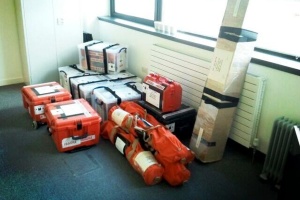dsfghdsfg
Next week the team members of the Scottish Ten project board planes in both Scotland and the USA, some flying east, some flying west, but all converging on Sydney, Australia. Sydney is an iconic modern world city, established as the first British colony on the continental-island in 1788, but long-before occupied for as much as 30,000 years prior by Aboriginal people.
Preparations for @SydOperaHouse project well underway! Read @JustinScans @CyArk blog here: http://bit.ly/10nWoGd @welovehistory @ddsgsa
With such a long history as Australia’s, there are many historic sites worthy of digital preservation across the vast “outback”. But there is one site which is iconic across the globe and has been duly appointed UNESCO World Heritage Status for its ‘creativity, both in architectural form and structural design.’ For this reason the Sydney Opera House was a clear choice for the next Scottish Ten project.
xxbeing a relatively young building, the Sydney Opera House is firmly established as an Australian national treasure that attracts over eight million visitors every year. It has become a symbol of both Sydney and Australia.
The Opera House consists of two main halls located side-by-side and seven performance venues – the Concert Hall, Joan Sutherland Theatre, Playhouse, Drama Theatre, The Studio, the Forecourt and the Utzon Room.
In 2007, the Sydney Opera House was listed as a World Heritage Site and described by UNESCO as representing ‘multiple strands of creativity, both in architectural form and structural design.’
Throughout April 2013, the Sydney Opera House will be laser scanned by the Scottish Ten
All images are courtesy of Jack Atley.
Why was Sydney Opera House included in the Scottish Ten?
The Sydney Opera House is one of the world’s most recognisable buildings.
As it prepares to celebrate its 40th anniversary, it was agreed that digital preservation of the building would contribute to its ongoing management, conservation, interpretation and educational programmes. Selecting a more modern building for scanning will also demonstrate the breadth of the Scottish Ten’s remit by benefiting historic buildings of all ages, shapes and sizes.
This project will also have wider benefits. It was recognised that the scanning would help strengthen and further the long standing historic and cultural links between Scotland and Australia, especially in the build-up to Scotland’s second Year of Homecoming in 2014.
The Scottish Ten has been working closely with the House’s management and trustees as well as the Australian Government throughout this project to ensure its aims and objectives are fully realised.
What are the Challenges of Scanning the WHS?
Sydney Opera House will present a considerable challenge to the Scottish Ten team. The logistics of capturing 100% data coverage on the sails cannot not be underestimated. The team will be working closely with the SOH building management team to develop a specially designed rig to facilitate scanning from the spines which run along the top of the sails. This will enable complete coverage which is not possible from ground level.
It is important to capture the context within which the Opera House sits, so the team will be working with special scanners typically used for capturing long-range data in mines to accurately record the Sydney Harbour area.
How Will the Data be Used?
The data will provide as-built survey information on the Opera House, and will be used as a building management tool. Interactive 3D models and educational resources can also be produced.
For three weeks we will be digitally documenting the structure and the ‘sails’ of the renowned facade. The collected data will be used by site managers to aide maintenance, preservation, and facilities management of this World Heritage Site, while its ‘born digital’ nature will make the data ideal to assist the Opera House’s education and interpretation programs.
The equipment, consisting of a multiple terrestrial LiDAR scanners, more tripods than you can shake–well, a big bright yellow stick at, laptops, DSLR cameras, and a myriad of memory cards and hard drives has already been shipped to site in advance of the team. This project will be unique and the team needs to be well-equipped for its challenges.
Lyn Wilson, the Scottish Ten project manager, alludes to the complex task ahead:
“The Sydney Opera House will present a considerable challenge to the Scottish Ten team. The logistics of capturing 100% data coverage on the sails cannot not be underestimated. The team will be working closely with the SOH building management team to develop a specially designed rig to facilitate scanning from the spines which run along the top of the sails. This will enable complete coverage which is not possible from ground level.
It is important to capture the context within which the Opera House sits, so the team will be working with special scanners typically used for capturing long-range data in mines to accurately record the Sydney Harbour area.”
Read more about the Sydney Opera House’s design, history, and its selection to be the 4th of 5 international sites of significance for the Scottish Ten project.






